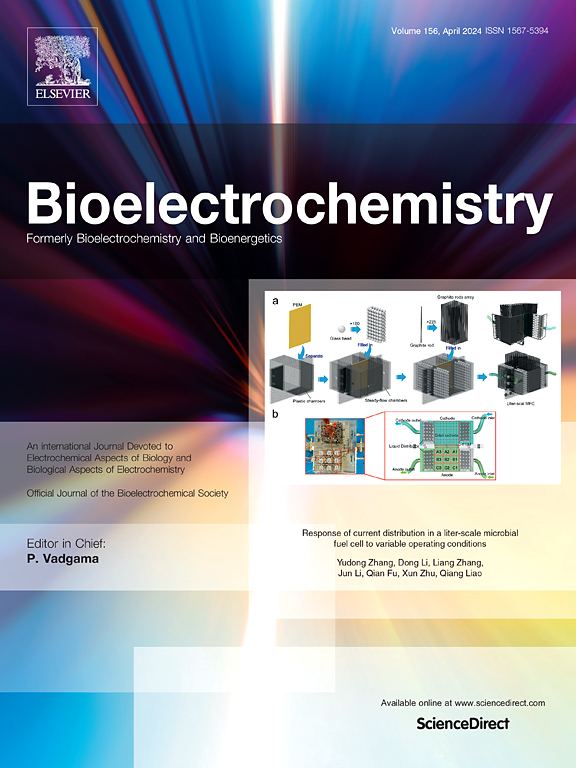Riboflavin-mediated extracellular electron transfer enhances microbiologically influenced corrosion of 316L stainless steel by Enterococcus faecalis
IF 4.8
2区 化学
Q1 BIOCHEMISTRY & MOLECULAR BIOLOGY
引用次数: 0
Abstract
316L stainless steel (SS) is widely used in medical implants due to its excellent mechanical properties. However, the increasing use of metallic implants has made microbiologically influenced corrosion (MIC) a significant safety concern, as it can release harmful metal ions in the body. Despite this risk, research on MIC behavior and mechanisms of 316L SS in the intestinal environment is limited. This study provides novel evidence that Enterococcus faecalis, an intestinal electroactive microorganism, contributes to MIC of 316L SS. MIC occurrence by E. faecalis was confirmed in nutrient-rich media and simulated intestinal fluid, with increased MIC rates under carbon starvation, suggesting an extracellular electron transfer (EET) mechanism. Electrochemical tests and material analyses supported a riboflavin-mediated EET mechanism, indicating that E. faecalis biofilms deteriorate the protective oxide layer on 316L SS through EET, with riboflavin accelerating corrosion. These findings identify EET as the primary mechanism by which E. faecalis enhances MIC in the gut, providing insights into intestinal corrosion risks and guiding the development of corrosion-resistant biomaterials.

核黄素介导的细胞外电子转移增强粪肠球菌对316L不锈钢的微生物影响腐蚀
316L不锈钢(SS)因其优异的机械性能而广泛应用于医疗植入物中。然而,越来越多的金属植入物的使用使得微生物影响腐蚀(MIC)成为一个重大的安全问题,因为它可以在体内释放有害的金属离子。尽管存在这种风险,但对316L SS在肠道环境中的MIC行为和机制的研究仍然有限。本研究为肠道电活性微生物粪肠球菌(Enterococcus faecalis)参与316L SS的MIC提供了新的证据,证实了粪肠球菌在富营养培养基和模拟肠液中发生MIC,并且在碳饥饿条件下MIC率增加,提示细胞外电子转移(EET)机制。电化学测试和材料分析支持核黄素介导的EET机制,表明粪肠杆菌生物膜通过EET破坏316L SS的保护氧化层,核黄素加速腐蚀。这些发现确定了EET是粪肠杆菌增强肠道MIC的主要机制,为肠道腐蚀风险提供了见解,并指导了耐腐蚀生物材料的开发。
本文章由计算机程序翻译,如有差异,请以英文原文为准。
求助全文
约1分钟内获得全文
求助全文
来源期刊

Bioelectrochemistry
生物-电化学
CiteScore
9.10
自引率
6.00%
发文量
238
审稿时长
38 days
期刊介绍:
An International Journal Devoted to Electrochemical Aspects of Biology and Biological Aspects of Electrochemistry
Bioelectrochemistry is an international journal devoted to electrochemical principles in biology and biological aspects of electrochemistry. It publishes experimental and theoretical papers dealing with the electrochemical aspects of:
• Electrified interfaces (electric double layers, adsorption, electron transfer, protein electrochemistry, basic principles of biosensors, biosensor interfaces and bio-nanosensor design and construction.
• Electric and magnetic field effects (field-dependent processes, field interactions with molecules, intramolecular field effects, sensory systems for electric and magnetic fields, molecular and cellular mechanisms)
• Bioenergetics and signal transduction (energy conversion, photosynthetic and visual membranes)
• Biomembranes and model membranes (thermodynamics and mechanics, membrane transport, electroporation, fusion and insertion)
• Electrochemical applications in medicine and biotechnology (drug delivery and gene transfer to cells and tissues, iontophoresis, skin electroporation, injury and repair).
• Organization and use of arrays in-vitro and in-vivo, including as part of feedback control.
• Electrochemical interrogation of biofilms as generated by microorganisms and tissue reaction associated with medical implants.
 求助内容:
求助内容: 应助结果提醒方式:
应助结果提醒方式:


